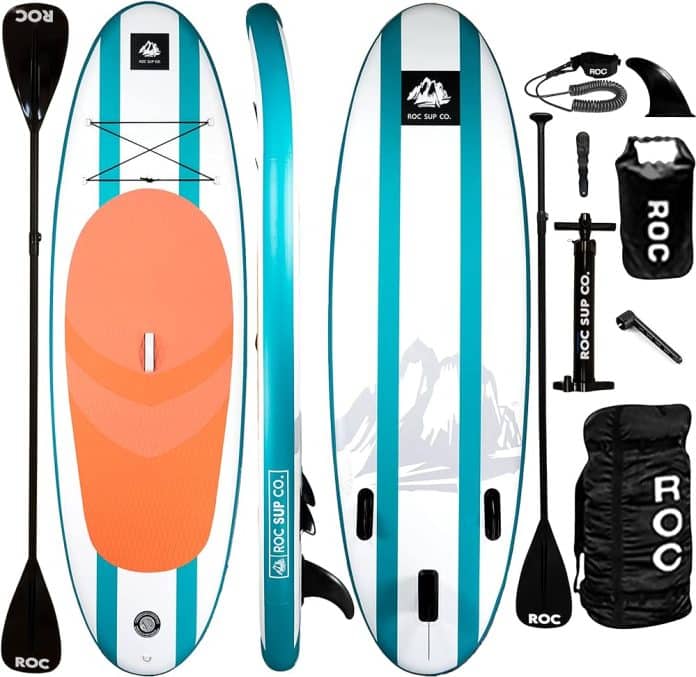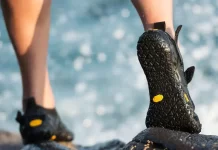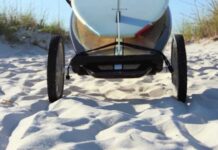In the world of stand-up paddleboarding (SUP), there is an ongoing debate about whether it’s better to paddle while kneeling or standing. Some enthusiasts argue that kneeling provides better stability and control, while others swear by the benefits of standing for a full-body workout. So, which approach reigns supreme? In this article, we will explore the pros and cons of both kneeling and standing paddleboarding techniques, helping you make an informed decision on how to paddle your way to aquatic bliss.
Benefits of Kneeling Paddle
Improved Balance and Stability
When paddling in a kneeling position, we have a lower center of gravity, which provides us with enhanced balance and stability on the water. This is especially advantageous for beginners or those who may feel less confident in maintaining their balance while standing on a paddleboard. By kneeling, we can distribute our weight evenly and have more control over our movements, thus reducing the chances of toppling over.
Reduced Risk of Falling
Kneeling while paddling significantly reduces the risk of falling into the water. This is particularly important for individuals who may be new to SUP or have concerns about their balance. By staying closer to the board’s surface, we have more stability and can maintain a solid grip on the paddle. This added stability allows us to fully enjoy our time on the water without worrying about taking an unplanned dip.
Easier Maneuverability
One of the key advantages of kneeling paddle is the increased maneuverability it offers. By being closer to the board, we have better control and agility, allowing us to navigate through tight spaces, maneuver around obstacles, and make quick turns with ease. Whether we are exploring calm waters or tackling more challenging conditions, kneeling paddle gives us the flexibility to maneuver effortlessly and enjoy a more dynamic paddling experience.
Engagement of Core Muscles
Kneeling paddle engages and strengthens our core muscles. By maintaining an upright posture while kneeling, we activate our abdominal, back, and hip muscles to stabilize and balance ourselves. These muscles play a crucial role in supporting our body and generating power during paddling. Regular kneeling paddle sessions can help us develop a strong core, leading to improved posture, better body mechanics, and enhanced overall fitness.
Considerations for Kneeling Paddle
Limited Visibility
One of the drawbacks of paddling in a kneeling position is the limited visibility compared to standing paddle. While kneeling, our line of sight may be restricted as we are closer to the water surface. This can make it harder to see potential hazards or effectively navigate in busy waterways. It is important to maintain awareness of our surroundings and adjust our paddling technique accordingly when kneeling to mitigate any safety concerns.
Less Efficient for Long Distances
Kneeling paddle may not be the most efficient option for covering long distances. Although it provides excellent maneuverability and stability, the kneeling position may cause increased muscle fatigue over time. The continuous flexion of our knees can strain them, making prolonged kneeling paddle a less comfortable choice for extended journeys. If we plan on embarking on longer SUP trips, it may be more practical to consider the standing paddle technique.
Greater Strain on Knees
While kneeling paddle offers advantages, we must be mindful of the increased strain it places on our knees. The prolonged pressure and bending of our knees can lead to discomfort or even injury, especially if we have pre-existing knee issues. To minimize strain, it is crucial to maintain proper form, use a cushioned knee pad for protection, and listen to our bodies. If we start to experience any knee pain or discomfort, it is important to rest and seek medical advice if necessary.
Limited Power Generation
Compared to standing paddle, kneeling paddle may result in limited power generation. When standing, we can harness the power of our entire body to generate forward momentum. In contrast, the kneeling position restricts our ability to utilize our legs and fully engage our lower body muscles. This can impact our speed and overall efficiency, particularly when facing strong currents or winds. If speed or power is a priority, standing paddle may be a better option.
Benefits of Standing Paddle
Better Visibility
One of the major advantages of standing paddle is the enhanced visibility it offers. When standing on a paddleboard, we have a higher vantage point, allowing us to see a larger area of the water surface. This increased visibility enables us to spot potential dangers, such as rocks, submerged objects, or other watercraft, more easily. By having a clear line of sight, we can navigate more confidently and ensure a safer paddling experience.
Increased Power Generation
Standing paddle enables us to harness the full power of our body to generate forward momentum. By incorporating our legs, core, and upper body in the paddling motion, we can generate more force and power, propelling ourselves through the water with greater speed and efficiency. This increased power generation is particularly beneficial when paddling against strong currents or winds, allowing us to maintain a steady pace and reach our destination more quickly.
Efficiency for Long Distances
If our paddleboarding adventures involve covering long distances, standing paddle can provide greater efficiency. The ability to utilize our legs and engage our entire body in the paddling process enables us to maintain a steady rhythm and conserve energy over extended periods. The lower impact on our knees compared to kneeling paddle also contributes to better endurance, allowing us to explore vast stretches of water with ease and enjoy prolonged paddleboarding journeys.
Engagement of Full Body
Standing paddle promotes the engagement of our full body, providing a comprehensive workout. By adopting a proper stance and technique, we activate our leg muscles, core, arms, and back, effectively toning and strengthening our entire body. This holistic approach to paddling not only improves our physical fitness but also enhances our overall coordination and balance. Additionally, the increased muscle engagement can contribute to improved posture and reduced risk of back pain.
Considerations for Standing Paddle
Higher Risk of Falling
Standing paddle carries a higher risk of falling compared to kneeling paddle. When standing on the paddleboard, our center of gravity is elevated, making it easier to lose balance, particularly in choppy or turbulent waters. It is essential to maintain a stable and relaxed stance, distribute our weight evenly, and be attentive to changes in the water conditions. With practice and improving balance, the risk of falling can be minimized, but it is important to be prepared to take an occasional plunge.
More Challenging Balance
Maintaining balance while standing on a paddleboard requires more effort and skill compared to kneeling paddle. Standing introduces an additional element of instability, as we need to continuously adjust our body position to counteract the motion of the water. This challenge can be particularly pronounced for beginners or individuals with limited core strength. However, with practice and gradual progression, we can develop better balance and stability, allowing us to fully enjoy the benefits of standing paddle.
Less Maneuverability
Standing paddle may offer less maneuverability than kneeling paddle. When standing, we have a slightly higher center of gravity, which can impact our ability to make quick and sharp turns. The larger body movements required for steering can be slightly less responsive than the more compact and agile movements of kneeling paddle. While it may not be as suited for navigating tight spaces or highly congested waterways, standing paddle still provides sufficient maneuverability for most recreational paddleboarding activities.
Increased Muscle Fatigue
The engagement of the full body in standing paddle can lead to increased muscle fatigue. The constant activation of our leg, core, and upper body muscles requires endurance and strength. Paddling for prolonged periods can lead to muscle fatigue, especially among beginners or those who are not regularly engaged in physical activities. To prevent excessive fatigue and discomfort, it is important to gradually increase the duration and intensity of our standing paddle sessions and listen to our bodies’ cues.
Factors Influencing Choice
Experience and Skill Level
Our level of experience and skill in paddleboarding should be considered when deciding between kneeling and standing paddle. Beginners or individuals who are new to SUP may find kneeling paddle more accessible and less intimidating. It provides a stable and controlled environment to learn and develop basic paddling skills. As we gain confidence and proficiency, we can progress to standing paddle and explore its benefits and challenges.
Water Conditions
The prevailing water conditions play a significant role in determining whether to paddle kneeling or standing. Calm and flat waters are generally more conducive to kneeling paddle, as it offers better maneuverability and stability. In contrast, when facing choppy or rough waters with stronger currents or winds, standing paddle becomes advantageous. The increased power generation and better visibility of standing paddle assist in navigating challenging conditions and maintaining control.
Fitness Level and Core Strength
Our fitness level and core strength are important considerations when choosing between kneeling and standing paddle. Kneeling paddle requires less physical exertion and may be suitable for individuals who are building up their fitness or have limited upper body strength. On the other hand, standing paddle demands greater muscle engagement and endurance. Those with better fitness levels and stronger core muscles will find standing paddle more suited to their abilities and may enjoy the added benefits of a more intense workout.
Personal Preference
Ultimately, personal preference should guide our decision in choosing between kneeling and standing paddle. Some individuals may simply find one position more comfortable or enjoyable than the other. It is important to try both techniques and consider our own preferences. We may even find that combining kneeling and standing paddle during our paddleboarding sessions provides the ideal balance of stability, power, and versatility.
Tips for Kneeling Paddle
Maintain an Upright Posture
When paddling in a kneeling position, it is crucial to maintain an upright posture. This helps engage our core muscles and ensures better balance and stability. Avoid slouching or leaning forward, as it may compromise our balance and strain our back muscles. By keeping our back straight and shoulders relaxed, we can maintain optimal body alignment and maximize the benefits of kneeling paddle.
Engage Core Muscles
Engaging our core muscles is key to successful kneeling paddle. By activating our abdominal and back muscles, we provide additional stability and support to our body. Focus on maintaining a strong core throughout the paddle stroke, and consciously contract the muscles in this area. Regularly practicing kneeling paddle will help strengthen our core muscles over time, leading to better posture and greater overall fitness.
Practice Proper Paddle Technique
To maximize the benefits of kneeling paddle, it is important to practice proper paddle technique. Ensure that the paddle blade is fully submerged in the water during each stroke, and avoid excessive splashing or hitting the water surface with the paddle. Engage your core and use your back muscles in a fluid motion to propel yourself forward. By striving for a smooth and efficient paddle stroke, we can increase our maneuverability and overall paddling performance.
Gradually Increase Time Kneeling
If we are new to kneeling paddle or have been primarily paddling in the standing position, it is advisable to gradually increase the amount of time spent kneeling. This allows our body to adjust to the new position and avoids excessive strain on our knees and muscles. Start with shorter kneeling intervals, interspersed with periods of standing paddle, and gradually extend the duration of kneeling as our comfort and strength improve.
Tips for Standing Paddle
Start with a Wide Stance
Maintaining a wide stance is essential for stability while standing paddle. Position your feet shoulder-width apart, with one foot slightly ahead of the other to establish a balanced and solid base. Keep your knees slightly bent to absorb any motion or changes in the water. Practicing a wide stance will enhance your balance and help prevent any accidental falls into the water.
Bend Your Knees
Bending your knees is vital for stability and balance when standing on a paddleboard. This slight knee flexion acts as a shock absorber, allowing you to effectively adapt to any movements or disruptions in the water. By keeping your knees softly bent throughout the paddle stroke, you create a more fluid movement and ensure better overall balance on the board.
Grip the Paddle Correctly
Properly gripping the paddle is crucial for efficient and effective standing paddle. Hold the paddle with both hands, ensuring a firm but relaxed grip. Your top hand should be positioned slightly down the paddle shaft, while your bottom hand rests comfortably on the handle. Having the correct paddle grip allows for better control and power during your strokes, ultimately improving your paddling experience.
Keep Your Eyes on the Horizon
Maintaining focus on the horizon is important for stability and balance while standing paddle. By looking ahead instead of down at the board or paddle, you improve your body alignment and overall balance. Keeping your eyes fixed on a point in the distance helps you anticipate any changes in the water, maintain proper posture, and navigate your paddleboard confidently and safely.
Combining Kneeling and Standing Paddle
Alternate Between Kneeling and Standing
Combining kneeling and standing paddle can offer the best of both worlds. By alternating between the two positions, we can adapt to changing conditions, vary our muscle engagement, and prolong our paddleboarding sessions without excessive fatigue or discomfort. Kneeling paddle provides stability and maneuverability, while standing paddle offers enhanced power and visibility. Experiment with finding the balance that works best for you and switch between the two positions as needed.
Flexibility in Changing Postures
One of the advantages of combining kneeling and standing paddle is the flexibility it provides. We can seamlessly transition between the two positions based on our preferences, fatigue levels, or environmental factors. This adaptability allows us to cater to our specific needs and strike a comfortable balance between stability and power. Being flexible in changing postures ensures an enjoyable and versatile paddleboarding experience.
Effective in Different Water Conditions
The combination of kneeling and standing paddle is particularly effective in various water conditions. Kneeling paddle is advantageous in calm waters or when maneuverability is essential, such as navigating through tight spaces or tranquil ecosystems. Alternatively, standing paddle excels in more demanding situations, such as choppy waters, stronger currents, or windier conditions. By adapting our paddleboarding technique to suit the water conditions, we can optimize our performance and safety on the water.
Mixing Power and Stability
Combining kneeling and standing paddle allows us to mix power and stability to our advantage. By utilizing kneeling paddle for its stability and easy maneuverability, we can conserve energy and focus on minimizing risks. When more power or speed is desired, transitioning to standing paddle enables us to engage our full body and generate greater force. This mix of power and stability ensures a well-rounded and dynamic paddleboarding experience.
Conclusion
Deciding whether to paddle kneeling or standing ultimately depends on individual preferences, abilities, and goals. By understanding the benefits and considerations of each technique, we can make an informed choice and tailor our paddleboarding experience to suit our needs. Factors such as experience, water conditions, fitness level, and personal preference all play a role in determining the most suitable paddleboarding style for each individual. Whether we choose to kneel, stand, or combine both, the key is to enjoy the process, stay safe, and continually explore new techniques to enhance our SUP adventures.





































